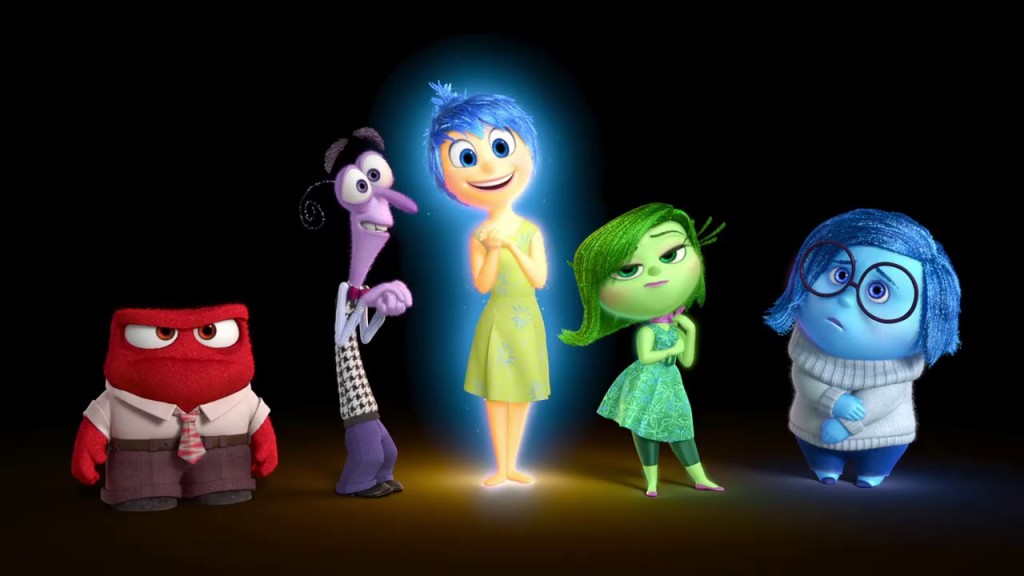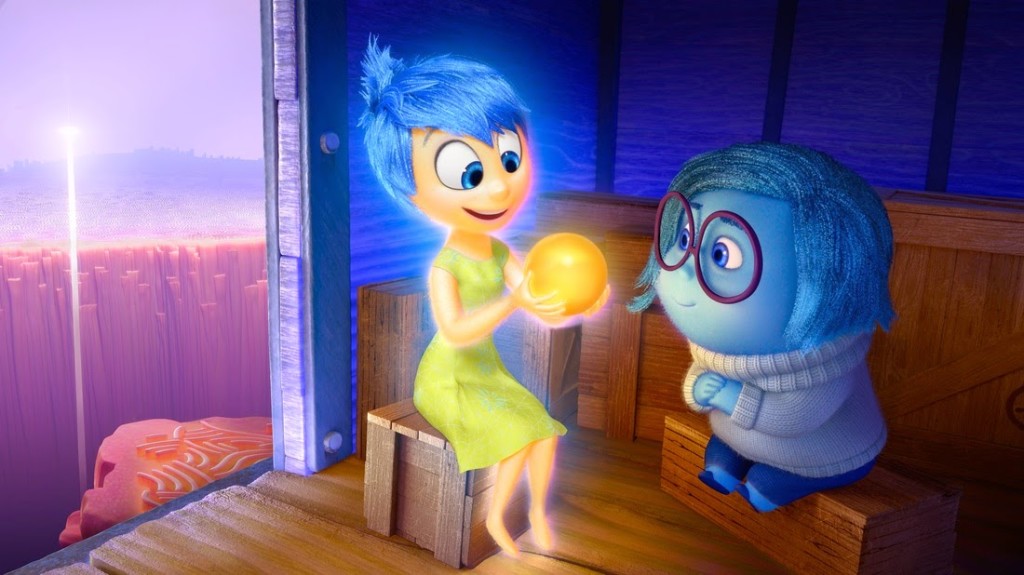Pixar continues to make a laughingstock out of the competition with its storytelling skillz.
Genre: Animation Drama/Comedy
Premise: We follow the physical embodiment of an 11 year-old girl’s emotions as her family makes the move from Minnesota to San Francisco.
About: Inside Out may not have taken down Chris Pratt and his dino-pals this weekend, but the animated feature did score a 91 million dollar take, making it the highest grossing original idea… EVER.
Writers: Meg LeFauve & Josh Cooley and Pete Docter (story by Pete Docter and Ronaldo Del Carmen)
Details: 94 minutes
One of the reasons Pixar is so successful is that they take chances. Unlike Disney or Dreamworks or Fox Animation, their first thought when coming up with an idea isn’t, “How many toys will it sell?” It’s “How can we write a great story that’s going to move people?” We’re talking about the company that brought the world an 80 year-old protagonist whose wife just died here.
Pixar also puts a ton of stock into feedback. They don’t follow the traditional model of “auteur Russian roulette” which offers a big ego-centric director carte blanche over their movie and whatever he comes up with, he comes up with.
Each draft of a Pixar screenplay is heavily scrutinized by the Pixar brain trust. If something’s not working, they’re going to tell you. And it’s one of the reasons the company has such a good track record. Their screenplays have been put through the ringer.
Inside Out is easily the most ambitious idea Pixar has ever had. Instead of featuring the go-to character groups of humans or animals, Pixar’s replaced them with things that don’t even exist. The movie doesn’t even take place in a realistic environment. It takes place inside someone’s mind, requiring the writers to create an entire new world with a new set of rules.
You’ve never seen anything like it and, outside of its impending sequels, will never see anything like it again. Nobody else would’ve had the balls to make this movie, and that alone is reason to take a closer look.
Inside Out is about an 11 year-old girl, Riley. Well, sorta. That’s another thing about Inside Out. Its main character isn’t really its main character. Its true main character is Joy, the feeling at the center of Riley’s brain. Joy isn’t the only feeling in this control center. There’s Sadness, Fear, Anger, and Disgust. This 5-thing group are in charge of making Riley go.
That group meets its most difficult challenge yet when the family unexpectedly moves from the quaint confines of rural Minnesota to the urban closet of San Francisco. Riley loses all her friends and her dearest love, hockey, and it’s up to Joy to keep the group together. For Joy has one goal and one goal only, to keep Riley as happy as possible.
This is where we’re introduced to the biggest risk of all in Inside Out, its mega-complex inner brain workings. There’s a lot going on here but the basic breakdown is that whenever Riley records a memory, it rolls into her “file system” in the form of a sphere that is color-coded based on the emotion associated with it. Joy is yellow, so happy memories come in yellow. Sadness is blue, so sad memories come in blue. Etc., etc.
Riley also has a series of “personality islands” inside her brain, each represented by a physical island we can see. There’s Goofball Island, Hockey Island, Family Island. When Riley acts like a monkey for no reason, for example, Goofball Island lights up excitedly.
Inside Out is about what happens when Riley’s core memories (another rule-set within the mind – basically the most important memories) start turning blue, which has never happened before. When Joy tries to fix this, her and Sadness accidentally get sucked into Riley’s long-term memory (think a never-ending stack of spheres), and must find a way back to the control center.
In the meantime, with only anger, disgust, and fear to guide her, Riley decides that she hates San Francisco and wants to go back to Minnesota. So she secretly buys a bus ticket and sneaks away to the bus station. It’ll be up to Joy (and Sadness) to get back to the control center in time to stop Riley from getting on that bus. The question is, how far will Joy go to save Riley? Will she ditch Sadness? And is eliminating sadness a good thing?
I went into a more detailed breakdown of today’s plot for a reason. This was a HUGE risk taken by Pete Docter and the crew at Pixar. While breaking storytelling rules often hurts a screenplay, it’s how you break the rules that makes your script unique, that differentiates it from everything else. So for that reason, rule-breaking empowers you.
I have no doubt that 99% of the executives outside of Inside Out would’ve told Docter that his screenplay contained too much exposition. It was like the anti-Mad Max: Fury Road (TLDR – George Miller avoids exposition at all costs). There are different emotions, multi-colored sphere memories, core memories, “islands” inside the brain.
I’m not exaggerating when I say that your average contest-reader would’ve laughed Inside Out out of the contest. The first 20 minutes of the movie are dedicated to our characters explaining how the brain works.
So why doesn’t this sink Inside Out? There are a couple of reasons. Those who have read my book may remember my rule for exposition in regards to The Matrix. The Matrix’s huge exposition centric sequence works because the thing that our characters expose is fascinating. The world we’re learning about is cool. And audiences are more open to accepting exposition when they’re rewarded with cool stuff.
Riley’s inner workings aren’t as cool as the secret of the Matrix. But they are pretty fascinating in their own right. I found myself curious how all this memory storage worked and while there was definitely a lot to keep track of, most of it was pretty neat. Where exposition kills your script is when it’s boring. When it’s not fascinating but rather feels like a test – like you’re being asked to remember a set of facts for later.
The second thing is that Inside Out has an “exposition friendly” character explaining how everything works. Exposition-friendly characters are characters who dole out information naturally. It all feels very obvious that this character would be explaining this stuff to us. Joy, who’s been working Riley’s controls for 11 years now, feels like the perfect guide in this scenario. Her telling us what’s going on makes sense.
This wouldn’t have worked as well had you added, say, an invisible narrator – someone whose sole purpose was to dole out exposition. This is the kind of thing that angered moviegoers in films like Blade Runner. Sure, our narrator was our hero, but conveying facts so people knew what he was doing didn’t sound like something that particular character would do. It felt unnatural.
Or, had Docter introduced, say, a therapist for Riley and tried to have the therapist be our window into how the mind worked. Can you imagine trying to fit all the relevant Inside Out exposition into a few therapy scenes? (“So you see, Riley, you have all these different emotions when you live your day-to-day life. There’s ‘Anger,’ there’s ‘Joy,’ there’s, ‘Sadness.’”) .
The point is, readers/viewers sense when you’re struggling to come up with a way to push exposition on them. If you can find an “exposition friendly” character to do that work for you (Ferris Bueller, for example), the exposition will come off invisibly as opposed to obviously. Exposition-heavy movies like Inside Out practically require you to come up with an exposition-friendly character.
One of the mantras I find myself offering more and more to writers when I give them notes is Pixar’s golden screenplay rule: “Simple story, complex characters.” 5 of the last 6 scripts I gave notes on fell into the “Complex story, complex characters” department. For whatever reason, new writers feel that it’s imperative they make their story as complex as possible.
A cursory glance at Inside Out might lead you to the conclusion that this story is complex as well. Like I pointed out, the thing has all these darn rules. In addition to having the control room, you have these islands in Riley’s head, long-term memory, abstract thought, daydreams and nightmares, the fact that we’re cutting between Riley’s brain and Riley’s life all the time.
But I want you to take a step back to see just how simple the story behind Inside Out is. The entire movie takes place in under 72 hours (it might be a little longer, but 72 hours is a good guess). Riley gets to San Francisco Day 1, hates school Day 2, and decides to go back to Minnesota on Day 3.
Then, inside Riley’s brain, we have a very simple GSU model pushing the story forward. The GOAL is for Joy to get back to the control center. The STAKES are the dangers of Riley heading out into the world on her own. And the URGENCY is that the bus leaves in a few hours. If Joy (and Sadness) don’t get to the control center quickly, Riley will be off to Minnesota.
I can’t stress the importance of this choice enough. Docter and the Pixar Crew realized that they were already asking a ton from their audience to sit through this very complex explanation of how the brain works. They knew if they then came up with some super complex storyline that lasted six months or something, it would’ve been too much for the audience to handle.
And I commend them for that because one viewing of Inside Out and you can tell they wanted this to be a lot bigger. This was originally meant to be a film about a girl entering puberty and all the complex emotions that come along with it and how do you deal with those emotions. But it looks like the Pixar Brain trust made Docter aware that if he went down that road, he was going to be biting off more than he could chew.
I have no doubt the subsequent drafts kept simplifying the storyline, cutting the timeline down again and again until it was only a few days long. And this led to the only real “knock” against Inside Out, which is that the physical character of Riley doesn’t go through all that much.
Since we only have a couple of days with her, her emotional breakdown is bare-bones. She kind of pouts and then decides to go back to Minnesota. But this was the right choice and it’s one of the hardest things about writing screenplays – is recognizing when your story is too ambitious for the medium and that you have to dial it back to make it work.
And that’s the reason Pixar is so good at what they do. They recognize these things and make the relevant changes so that the story works.
[ ] what the hell did I just watch?
[ ] wasn’t for me
[ ] worth the price of admission
[x] Arclight prices impressive
[ ] genius
What I learned: For a new writer, this has to be confusing. You read about Mad Max: Fury Road, and the celebration behind its minimalist exposition. Then you hear about Inside Out, which has more exposition in it than all of the Harry Potter films combined. Which one is right? Neither. Every story has its own exposition requirements. It’s something that should be taken into consideration before every movie you write. “Is this going to be an exposition challenge?” If you come up with an idea that requires a ton of exposition, then you better have a plan for how to include that exposition that doesn’t grind your screenplay to a halt. However, once you commit to an idea, commit to its exposition. If something requires a lot of exposition and you try to pull a George Miller: Fury Road (boil 15 pages of exposition into 1), you’re going to have a lot of confused readers because you’ve excluded a ton of information required to understand the story. A script’s exposition requirements are a script’s exposition requirements. Minimize as much as you can, but make sure to include every piece of info the audience needs to understand the story. You can see the value of that approach here in Inside Out.





